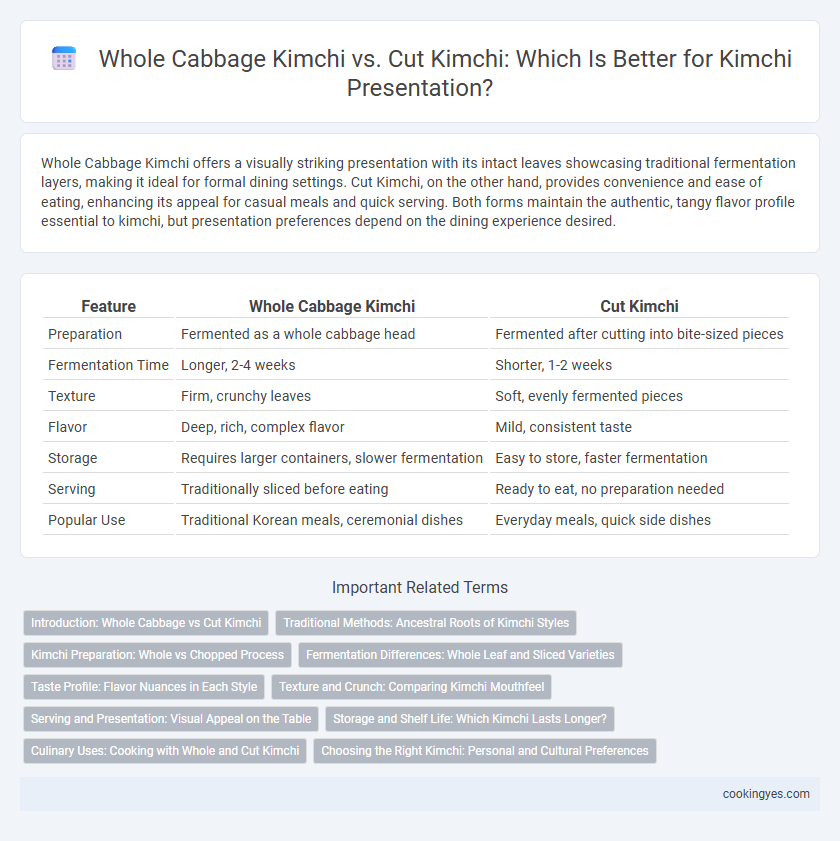Whole Cabbage Kimchi offers a visually striking presentation with its intact leaves showcasing traditional fermentation layers, making it ideal for formal dining settings. Cut Kimchi, on the other hand, provides convenience and ease of eating, enhancing its appeal for casual meals and quick serving. Both forms maintain the authentic, tangy flavor profile essential to kimchi, but presentation preferences depend on the dining experience desired.
Table of Comparison
| Feature | Whole Cabbage Kimchi | Cut Kimchi |
|---|---|---|
| Preparation | Fermented as a whole cabbage head | Fermented after cutting into bite-sized pieces |
| Fermentation Time | Longer, 2-4 weeks | Shorter, 1-2 weeks |
| Texture | Firm, crunchy leaves | Soft, evenly fermented pieces |
| Flavor | Deep, rich, complex flavor | Mild, consistent taste |
| Storage | Requires larger containers, slower fermentation | Easy to store, faster fermentation |
| Serving | Traditionally sliced before eating | Ready to eat, no preparation needed |
| Popular Use | Traditional Korean meals, ceremonial dishes | Everyday meals, quick side dishes |
Introduction: Whole Cabbage vs Cut Kimchi
Whole cabbage kimchi, known as baechu kimchi, preserves the traditional fermentation process by fermenting the cabbage intact, resulting in a layered texture and rich, complex flavors. Cut kimchi, or chopped kimchi, involves slicing the cabbage into smaller pieces, enhancing faster fermentation and easier consumption, making it ideal for quick meals and modern presentations. Both styles offer distinct textural and flavor profiles, influencing their culinary uses and presentation aesthetics in Korean cuisine.
Traditional Methods: Ancestral Roots of Kimchi Styles
Whole cabbage kimchi, known as "Baechu Kimchi," preserves the traditional fermentation process using entire Napa cabbages, maintaining the authentic texture and layered flavor developed over generations in Korean ancestral kitchens. Cut kimchi, or "Sliced Kimchi," offers a modern adaptation that accelerates fermentation and enhances ingredient absorption, though it diverges from the time-honored methods rooted in Korean heritage. Both styles reflect distinct cultural practices, with whole cabbage kimchi embodying the ritualistic art of kimjang, the communal seasonal preparation that honors Korea's deep culinary lineage.
Kimchi Preparation: Whole vs Chopped Process
Whole cabbage kimchi involves fermenting the intact napa cabbage, preserving its crisp texture and allowing flavors to develop gradually over time through deep penetration of the seasoning paste. Cut kimchi uses chopped cabbage pieces that accelerate fermentation by increasing surface area exposure, resulting in a faster, more evenly distributed flavor profile. The choice between whole and cut kimchi impacts fermentation speed, texture retention, and visual presentation, influencing culinary uses and taste preferences.
Fermentation Differences: Whole Leaf and Sliced Varieties
Whole cabbage kimchi ferments more slowly due to its intact leaves, which limit the exposure of inner layers to salt and air, resulting in a milder, more complex flavor profile. In contrast, cut kimchi allows for faster fermentation as the sliced surfaces increase contact with seasoning and microbes, producing a tangier and more robust taste. These fermentation differences significantly impact the texture and depth of flavor, influencing the presentation and culinary use of each variety.
Taste Profile: Flavor Nuances in Each Style
Whole cabbage kimchi offers a deeper fermentation flavor due to slower salt absorption, resulting in a balanced umami richness and subtle tanginess. Cut kimchi presents a more immediate and pronounced spicy kick, with enhanced permeability allowing faster flavor infusion and a sharper, zestier taste. Both styles showcase unique flavor nuances shaped by fermentation time and ingredient exposure.
Texture and Crunch: Comparing Kimchi Mouthfeel
Whole cabbage kimchi offers a layered texture that gradually softens while maintaining a satisfying crunch from the outer leaves, providing a complex mouthfeel with each bite. Cut kimchi delivers a more uniform crunch and immediate tang, as smaller pieces absorb seasoning evenly and retain crispness throughout. The contrast between the fibrous, slightly chewy whole cabbage and the consistent, crisp chunks of cut kimchi influences presentation choices based on desired texture and eating experience.
Serving and Presentation: Visual Appeal on the Table
Whole cabbage kimchi commands attention with its dramatic, intact layers and vibrant red hues, making it a striking centerpiece for traditional Korean meals. Cut kimchi, with its bite-sized pieces and uniform texture, offers versatility in plating and ease of serving in communal dishes. The choice between whole and cut kimchi influences not only visual impact but also practical presentation and guest interaction at the dining table.
Storage and Shelf Life: Which Kimchi Lasts Longer?
Whole cabbage kimchi typically has a longer shelf life than cut kimchi due to its intact leaves, which reduce exposure to air and slow fermentation. Cut kimchi ferments faster as the increased surface area accelerates microbial activity, leading to quicker souring and spoilage. Properly stored in airtight containers at low temperatures, whole cabbage kimchi can last several months, whereas cut kimchi is best consumed within a few weeks for optimal flavor and texture.
Culinary Uses: Cooking with Whole and Cut Kimchi
Whole cabbage kimchi retains its texture, making it ideal for grilling or serving as a centerpiece in traditional Korean dishes like baechu kimchi jjigae, where the intact leaves absorb flavors slowly. Cut kimchi offers convenience and quicker fermentation, perfect for stir-fries, kimchi fried rice, and soups, enhancing distribution of its tangy, spicy flavor throughout the dish. Both forms showcase the versatility of kimchi in cooking, with whole cabbage kimchi adding a rustic, hearty element, while cut kimchi integrates seamlessly for uniform taste and texture.
Choosing the Right Kimchi: Personal and Cultural Preferences
Whole cabbage kimchi preserves the traditional fermentation process, offering a robust flavor and texture that appeals to those valuing authenticity and ceremonial presentation. Cut kimchi provides convenience and ease of consumption, favored in modern households and casual settings where quick serving is essential. Personal and cultural preferences ultimately guide the choice, with whole cabbage kimchi reflecting heritage and rituals, while cut kimchi aligns with practicality and everyday use.
Whole Cabbage Kimchi vs Cut Kimchi for presentation Infographic

 cookingyes.com
cookingyes.com